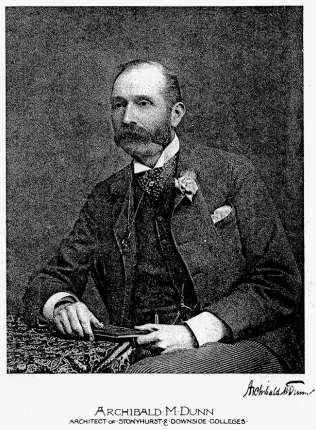Archibald Matthias Dunn
- Birth date 23 October 1832 at Wylam, Northumberland
- Christening 16 November 1832 at Newcastle upon Tyne, Northumberland
- Married 2 January 1862 to Sarah Ellen Armstrong (1841-1917) at St Andrew’s Church, Newcastle
- Death date 17 January 1917, “The Wood House” Branksome Park, Bournemouth
- Probate 12 April 1917. Estate - £36,820
Not to be confused with William Henry Dunn (qv) mayor of Gateshead, who was in partnership with Alderman Matthew Thompson (1822 or 3-1878). at Gateshead. See also death of Matthew Thompson of Thompson and Dunn, architects. [Newcastle Journal 21 May 1878 page 4]
Archibald Mathias Dunn was born at Wylam on 23 October 1832, the son of Matthias Dunn, a mining engineer and manager and one of the first Government Inspectors of Mines for the North-East. His mother was Margaret Warden Hill (nee Rennie) born in Scotland. He was educated at Ushaw and Stonyhurst College before receiving his architectural training in the office of Charles Hansom of Bristol, the younger brother of Joseph Aloysius Hansom of hansom cab fame.
Mr. Archibald M. Dunn, of 23, Eldon-square, Newcastle-upon-Tyne, is the senior partner in the well-known firm of Messrs. Dunn, Hansom, and Dunn. Previous to being associated with his partner, Mr. Hansom, Mr. Dunn was known in connection with many R.C. churches and other buildings in the North of England, the most notable amongst his churches being the large Romanesque one built for the Dominicans at Newcastle-on-Tyne. Many of his important works have been done in conjunction with Mr. Hansom, such as the colleges and chapels at Stonyhurst for the Jesuits, and the church and college at Downside for the Benedictines—all on a large scale; the College Chapel at Ushaw, St. Bede's College, Manchester (terracotta), and the New University College of Medicine at Newcastle, etc. Amongst the churches in various towns their most important is the new Roman Catholic Church at Cambridge, hardly yet completed, and of which we gave a view in the Building News for June 26, 1885, and we shall shortly give an interior of the building. Mr. Dunn appeared as an author a few years ago, publishing "The Notes and Sketches of an Architect." In the Building News for 28 February last we published the portrait of Mr. Hansom and gave at the same time a list of the more remarkable buildings carried out by this firm, so that a repetition here is unnecessary. Mr. Dunn's portrait is by Mr. Downey, of Ebury street, S.W. [Building News 18 April 1890 page 547]
In 1862 Archibald Mathias Dunn married Sara (or Sarah) Ellen, a daughter of Hugh C. Armstrong of Newcastle upon Tyne and Bromley, Kent. Mrs Dunn is said to have given devoted services to the poor after her marriage. In 1901 Archibald and Sarah Dunn moved to “The Wood House” Branksome Park, Bournemouth, where he died on 17 January 1917.
Obituary Builder, 112, 4 May 1917, p.288. Obituary.
Obituary RIBA Journal v24, 1916-17, p 104, - death notice only,
Obituary RIBA Journal v24, 1916-17, p 104, page 129
Obituary Newcastle Daily Chronicle 19 January 1917 page 3
Reference Building News, vol 58, 18 April 1890, p.547. Biography.
Reference Builder, 7 November 1896, p.729.Presidential Address to NAA, ‘An Ideal Architect’
Reference "Notes and Sketches of an Architect," illustrated by his own drawing (1886)
Reference Dunn, Archibald J. Catholic Who’s Who and Yearbook 1908 page 126-127
Reference Dunn, Mrs Archibald — Sara H., Catholic Who’s Who and Yearbook 1908 page 126-127
Revised 3 September 2024
Partnerships
| Name | Designation | Formed | Dissolved | Location |
|---|---|---|---|---|
| Dunn and Hansom | Architectural practice | 1871 | 1893 | Newcastle-upon-Tyne |
